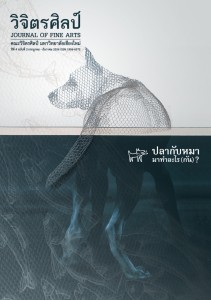“ปลากับหมามาทำอะไร ?”
Main Article Content
Abstract
ผลงานชุดนี้มีแนวความคิดในการสร้างสรรค์ นำเสนอถึงปัญหาของขาหลังและการเยียวยา ด้วยการถักทอหมู่ปลาต่างๆ ขึ้นเป็นผืนผ้าห่มกว้างใหญ่สำหรับห่มคลุมให้พลังแก่สกายเลอร์ รวมทั้งให้สายน้ำและหมู่ปลาเป็นตัวหลักในการขับเคลื่อนเวียนว่ายบำบัดรักษา พยุงให้สกายเลอร์มีสุขภาพดี ก้าวเดินได้อย่างมั่นคงต่อไป โดยสร้างสรรค์เป็นศิลปะอินสตอลเลชั่น ที่ประกอบด้วยประติมากรรมย่อย 5 ชิ้น ในการแสดงส่วนของปัญหาขาหลัง และการบำบัดด้วยหมู่ปลา ซึ่งได้ทำการอธิบายถึงความหมายของแต่ละชิ้นไว้ครบถ้วน
การสร้างสรรค์ผลงานชุดนี้ นอกจากได้ผลสัมฤทธิ์ตามวัตถุประสงค์และแนวความคิดแล้ว ยังได้รับประโยชน์จากสิ่งที่พบหลายประการ ทั้งการเยียวยาความรู้สึก และสิ่งที่เพิ่มขึ้นจากการสร้างสรรค์ ซึ่งสามารถพัฒนาเข้าสู่การสร้างสรรค์ในอนาคตได้อย่างหลากหลายทั้งด้านเนื้อหาและรูปลักษณ์
The Study on the Form and Chronology of the Main Stupa, Ku Pra Chao and Ku Klang Num, of Wat Koh Klang, Pa Sang District, Lamphun Province.
This article presents the new findings from the study on the form and chronology of the main stupa, ‘Ku’ (mandapa) Pra Chao and Ku Klang Nam, Pa Sang District, Lamphun Province. Conventionally, academics analyzed and identified that the main stupa were from around 19th Buddhist century because their form and architectural style were like those in Lan Na culture which had been influenced by Burmese-Pagan culture. However, the study leads to the findings that these the main stupa of Wat Koh Klang should be from 21st Buddhist century and had been built and renovated. The original construction took place in the reign of King Tilokaraja (1984 - 2030 B.E.) of Lan Na Kingdom. The style of the main pagoda was influenced by the form of Chiang Yan stupa of Wat Pra That Haribunjaya, Lamphun District. This stupa is a five-peaked one the style of which was inspired by the five-peaked stupa in Mahabodhi Temple, Bodh Gaya. The renovation was carried out in the reign of King Yod Chiang Rai (2030 - 2038 B.E.). The bell-shaped form of the main stupa was changed to Ceylonese style, which reflects the influences from Singhalese Buddhism.
As for the chronology, Ku Phra Chao is assumed to be built in the reign of King Mueng Kaeo (2038 - 2069 B.E.) or around the middle of 19th Buddhist century because the pagoda has an arch on each of its four cardinal points, which are connected to each other, which is like the style of Ku Pra Chao Kaen Chan of Wat Maha Bodharama (Ched Yod) in Chiang Mai Province, which was built in 2053 B.E., as mentioned in Chinakalamalipakorn Doctrine, which is in the reign of King Mueng Kaew.
As for Ku Klang Num Pagoda, it is assumed to be built in mid 21st Buddhist century because its style is the mixture between the five-peaked stupa as the old principle stupa of Wat Koh Klang, and Chiang Yan stupa, which consists of an arch on each of its four cardinal points, which are connected to each other. This style is like the styles of Ku Phra Chao from Wat Koh Klang and Ku Phra Chao Kaen Chan. The composition of this ‘Ku’ (mandapa), which is encompassed by water, reflects the Lan Na concept of the universe through the architecture. The mandapa symbolizes Mount Meru and the water surrounding the pagoda symbolizes Maha Nathee Seethandorn or the great ocean that surrounds Mount Meru, the Centre of the Universe.


